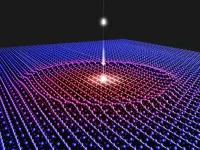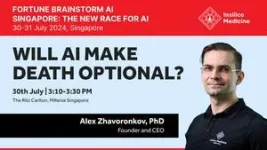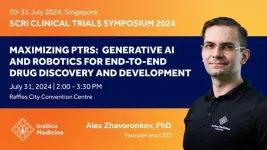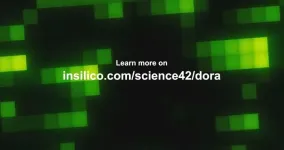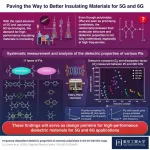(Press-News.org) UPTON, N.Y. — Scientists from the U.S. Department of Energy’s (DOE) Brookhaven National Laboratory have created the first-ever atomic movies showing how atoms rearrange locally within a quantum material as it transitions from an insulator to a metal. With the help of these movies, the researchers discovered a new material phase that settles a yearslong scientific debate and could facilitate the design of new transitioning materials with commercial applications.
This research, recently published in Nature Materials, marks a methodological achievement; the researchers demonstrated that a materials characterization technique called atomic pair distribution function (PDF) analysis is feasible — and successful — at X-ray free-electron laser (XFEL) facilities. PDF is typically employed for synchrotron light source experiments, during which samples are bombarded with pulses of X-rays. By studying how X-ray diffraction patterns change after interacting with materials, scientists can better understand the properties of those materials. But these experiments are restricted by the shortest X-ray pulses that can be generated.
“It’s like a camera’s shutter speed,” explained Jack Griffiths, co-lead author of the paper. “If you are taking a photo of something changing faster than your camera’s shutter speed, your photo will be blurry. Like a quick shutter speed, shorter X-ray pulses help us view quickly changing materials in more detail.” Griffiths was a postdoctoral researcher in the X-ray Scattering Group within Brookhaven’s Condensed Matter Physics & Materials Science (CMPMS) Department when the research was conducted and is now a postdoctoral researcher at the National Synchrotron Light Source II (NSLS-II), a DOE Office of Science user facility at Brookhaven Lab.
Synchrotron light sources are excellent for characterizing materials that aren’t changing or materials that change over minutes to hours, like batteries as they charge and discharge. But this group of scientists wanted to observe material changes on picosecond time scales.
“It’s hard to imagine how fast a picosecond really is,” Griffiths said. In one second, light can travel around the Earth seven and a half times. But in one picosecond, light can only travel one third of a millimeter. “The time scales are almost incomparable.”
So, the scientists brought the PDF technique to an XFEL called the Linac Coherent Light Source (LCLS), a DOE Office of Science user facility at DOE’s SLAC National Accelerator Laboratory that generates incredibly bright and short pulses of X-rays.
“When you are doing something for the first time, there is always this aspect of unknown. It can be nerve-racking but also very exciting,” said Emil Bozin, the other co-lead author and a physicist in the CMPMS X-ray Scattering Group. “We knew the core limitations of bringing PDF to an XFEL, but we didn’t really know what to expect.”
With the fast “shutter speed” of LCLS, the scientists were able to create movies elucidating atomic movement, like that which occurs when their quantum material sample transitioned between a metal and an insulator.
“I was simply blown away by how well it worked,” said Simon Billinge, a physicist in the X-ray Scattering Group and a professor at Columbia University’s School of Engineering and Applied Science.
“It’s similar to needing a navigation app,” Billinge added. “You know where you are now and what your destination is, but you need the app to give you a route or a few route options. Ultrafast PDF was our navigation app.”
Understanding these atomic routes is an important first step for designing transitioning materials with a myriad of applications in computing, chemistry, and energy storage. Once scientists understand how the materials transition, they can then manipulate the atomic routes and design materials optimized for commercial applications. Computer memory materials, for example, transition to a different phase when a file is saved. In this case, it is important to have materials that don’t require a lot of energy to switch phases. But they also have to be resistant to unwanted phase switching and data corruption over long periods of time.
“Getting PDF working with an XFEL was the result of a huge organizational effort,” said Ian Robinson, the X-ray Scattering Group leader at Brookhaven Lab and a professor at the London Centre for Nanotechnology at University College London (UCL). For example, Robinson noted, “we closely coordinated with Sébastien Boutet and Vincent Esposito from LCLS to determine that the Macromolecular Femtosecond Crystallography (MFX) beamlines were the most promising for the PDF technique.”
The team also included physicists from Columbia University, University of Wisconsin, Madison, DOE’s Argonne National Laboratory, and the United Kingdom's Science and Technology Facilities Council.
With their successful proof-of-principle experiments, the researchers were eager to look into another phase transition of the quantum material, which scientists study as a “model” for other useful materials. And the excitation of the material with a laser pulse led to an exciting discovery.
Uncovering a new material phase
Like the insulator to metal transition of this quantum material, some material transitions are driven by changes in temperature, pressure, or magnetic field. But because these environmental changes can occur naturally or unintentionally, they can be unreliable for some applications. When it comes to computing, it is important that the materials responsible for storing files don’t switch phases just because a room became too hot or cold.
So, the researchers looked into “non-equilibrium” transitions, a change in material state induced by a reliable and controlled trigger. In this case, they zapped the quantum material with a laser pulse.
Even though the laser light perturbed just a few atoms, those atoms’ neighbors responded to the change. And then the neighbors’ neighbors felt the impact, until the local change had propagated throughout the entire quantum material.
“It was just like how an earthquake on the ocean floor can disrupt a little bit of water and create a wave that eventually reaches the edge of the ocean,” added Billinge.
Using ultrafast PDF, the researchers closely observed atomic movement as the sample was bombarded with laser pulses. And for the first time, they directly observed the quantum material transitioning to a new state that had not yet been identified.
“This was like discovering a new, hidden phase of matter that is inaccessible during equilibrium transitions,” said Bozin.
The scientists’ discovery contributed to a yearslong debate of what really happens when certain quantum materials are excited by a laser; it is not just like heating the material, but rather the generation of a transient “metastable” intermediate state.
Interestingly, the material was disordered for tens of picoseconds, “even though it started and ended in an ordered state,” Griffiths said.
Robinson added, “The discovery of a transient state represents a new phase of the material, which lives for just a short time. This is a vital sign that an undiscovered, fully stable material may be lying at a nearby composition.”
Scientists are eager to uncover these “hidden” materials. But they also want to unlock the full potential of the new ultrafast PDF technique.
“There are several forms of complex phase switches that occur in quantum materials, and we plan to explore them with ultrafast PDF,” said Bozin. “Understanding these phase transitions can facilitate the development of commercial materials. But the scientific community can also use the technique to answer fundamental physics questions, explore ultrafast phenomena, and build better superconductors.”
He added, “Though we answered questions about material transition pathways, it seems as if we have opened a door rather than closing one.”
Like this project, future ones will not be successful without multidisciplinary collaboration.
“We didn’t just use the LCLS facilities at SLAC,” Billinge explained. “The people there were also integral to making ultrafast PDF a success.”
The Brookhaven team is ready to optimize the ultrafast PDF technique, especially as LCLS is upgraded to LCLS-II-HE, which will enable even higher resolution molecular movies.
“There is international interest in making this a routine and successful technique,” said Bozin. “And we are looking forward to being a part of it.”
Sample preparation was done at the Center for Functional Nanomaterials, a DOE Office of Science user facility at Brookhaven Lab. Additional measurements were taken at the Advanced Photon Source, a DOE Office of Science user facility at Argonne.
This work was mainly supported by the DOE Office of Science.
Brookhaven National Laboratory is supported by the Office of Science of the U.S. Department of Energy. The Office of Science is the single largest supporter of basic research in the physical sciences in the United States and is working to address some of the most pressing challenges of our time. For more information, visit science.energy.gov.
Follow @BrookhavenLab on social media. Find us on Instagram, LinkedIn, X, and Facebook.
Related Links:
Scientific paper: “Resolving length-scale-dependent transient disorder through an ultrafast phase transition”
END
Atomic 'GPS' elucidates movement during ultrafast material transitions
Scientists demonstrated that a materials characterization technique can be successful at a new type of facility, and they used it to discover a hidden materials phase
2024-07-26
ELSE PRESS RELEASES FROM THIS DATE:
UMBC scientists work to build “wind-up” sensors
2024-07-26
An international team of scientists, including two researchers who now work in the Center for Advanced Sensor Technology (CAST) at UMBC, has shown that twisted carbon nanotubes can store three times more energy per unit mass than advanced lithium-ion batteries. The finding may advance carbon nanotubes as a promising solution for storing energy in devices that need to be lightweight, compact, and safe, such as medical implants and sensors. The research was published recently in the journal Nature Nanotechnology.
Sanjeev Kumar Ujjain, from CAST, was a lead researcher on the work. He started the project while at Shinshu University, in Nagano, Japan, and continued after arriving ...
Researchers receive McKnight award to study the evolution of deadly brain cancer
2024-07-26
Scientist Dr. Aparna Bhaduri, assistant professor of medicine and biological chemistry, and neurosurgeon Dr. Kunal Patel, assistant professor of neurosurgery, both part of the UCLA Health Jonsson Comprehensive Cancer Center, have received the 2024 Neurobiology of Brain Disorders Award from the McKnight Endowment Fund for Neuroscience, which supports innovative research by U.S. scientists who are studying neurological and psychiatric diseases.
The award, $300,000 over the next three years, supports their efforts in gaining a deeper understanding of the microenvironment's role in shaping human glioblastoma, an aggressive type of brain cancer that is fast growing and difficult ...
Heather Dyer selected as the 2024 ESA Regional Policy Award Winner
2024-07-26
The Ecological Society of America (ESA) will present its 17th annual Regional Policy Award to Heather Dyer, Chief Executive Officer of the San Bernardino Valley Municipal Water District, Sunday, Aug. 4, 5:00 p.m. PDT, during the ESA Annual Meeting Opening Plenary. The ESA annual award recognizes an elected or appointed local policymaker whose record reflects the use of ecological science to inform policy decisions.
“ESA is honored to recognize Dyer,” said ESA President Shahid Naeem. “It’s rare for a biologist with ecosystems expertise to transition from technical science work to executive ...
New study disputes Hunga Tonga volcano’s role in 2023-24 global warm-up
2024-07-26
New research from a collaborative team featuring Texas A&M University atmospheric scientist Dr. Andrew Dessler is exploring the climate impact of the 2022 Hunga Tonga volcano eruption and challenging existing assumptions about its effects in the process.
The remarkable two-day event, which occurred in mid-January 2022, injected vast amounts of volcanic aerosols and water vapor into the atmosphere. Historically, large volcanic eruptions like Tambora in 1815 and Mt. Pinatubo in 1991 have led to significant cooling effects on the global climate by blocking sunlight with their aerosols. ...
Climate is most important factor in where mammals choose to live, study finds
2024-07-26
While human activity has had a massive effect on the natural world, a new study from North Carolina State University finds that climate is still the most influential factor in determining where mammals can thrive. The work sheds light on how climate change will affect wildlife populations.
Roland Kays, lead author of a paper on the work, said the study’s goal was to compare the importance of climate versus human factors in where mammals chose to live. To do so, researchers collected data on 25 mammal species from 6,645 locations across the United States. The study is one of the largest camera trap data analyses ever done. The data came ...
New study highlights global disparities in activity limitations and assistive device use
2024-07-26
A new study of over 175,000 people in 25 countries revealed that individuals in low- and middle-income countries face greater challenges with daily activities and are less likely to use assistive devices compared to those in high-income countries. These findings raise concerns about the global burden of disability, particularly in low-income countries.
Despite decreases in death and cardiovascular disease rates and increases in life expectancy worldwide, people in low- and middle-income countries still ...
Study finds targeting inflammation may not help reduce liver fibrosis in MAFLD
2024-07-26
Researchers at UCLA Health uncovered new information about the role inflammation plays in mitigating liver fibrosis, which is associated with metabolic-associated fatty liver disease (MAFLD), one of the most common diseases in the world affecting up to 40 percent of U.S. adults. While inflammation in the liver has long been considered a prerequisite to developing liver fibrosis, the scarring and thickening of tissue that can impair the liver’s ability to function, this new research suggests ...
Meet Insilico in Singapore: Alex Zhavoronkov PhD shares insights into various aspects of AI-powered drug discovery
2024-07-26
From July 30-31, Alex Zhavoronkov, PhD, founder and co-CEO of clinical stage artificial intelligence (AI)-driven drug discovery company Insilico Medicine will be attending SCRI Clinical Trials Symposium 2024 at Raffles City Convention Centre, and Brainstorm AI 2024: The New Race for AI at The Ritz-Carlton, Millenia Singapore, sharing strategic insights with global leaders across the technology and healthcare industries.
On 2:00 p.m, July 31, Alex Zhavoronkov PhD will be speaking at the session named “Methodologies and Considerations for ...
Insilico Medicine introduces Science42: DORA, the intelligent writing assistant for accelerated research
2024-07-26
Writing research papers is critical for disseminating scientific findings, but it does come with efficiency burdens, particularly for early-career researchers and non-native English speakers. A survey published in Nature in 2018 indicated that approximately 37% of respondents reported that they spend more than 20 hours a week on writing and revising scientific papers.
Recent progress in Natural Language Processing (NLP) technology, particularly with the rise of Generative Pre-trained Transformers (GPT) and other Large Language Models (LLMs), has equipped researchers with a powerful set of tools for processing extensive amounts of literature ...
A deep dive into polyimides for high-frequency wireless telecommunications
2024-07-26
As 5G technologies continue to evolve, scientists and engineers are already exploring new ways to turn things up a notch for 6G. One of the biggest challenges to address in both 5G and 6G is the many detrimental effects that operating at extremely high frequencies has on wireless communications. At frequencies nearing the terahertz range, problems such as signal attenuation and interference are more prominent, and maintaining signal integrity becomes much harder.
Some of these issues can be greatly mitigated by using insulating materials with exceptional dielectric properties. Glass- and ceramic-based insulating materials ...
LAST 30 PRESS RELEASES:
Post-stroke injection protects the brain in preclinical study
Cardiovascular risk score predicts multiple eye diseases
Health: estimated one in ten British adults used or interested in GLP-1 medications for weight loss
Exercise to treat depression yields similar results to therapy
Whooping cough vaccination for pregnant women strengthens babies’ immune system
Dramatic decline in new cases of orphanhood in Uganda driven by HIV treatment and prevention programs
Stopping weight loss drugs linked to weight regain and reversal of heart health markers
Higher intake of food preservatives linked to increased cancer risk
Mass General Brigham–developed cholera vaccine completes phase 1 trial
First experimental validation of a “150-year-old chemical common sense” direct visualization of the molecular structural changes in the ultrafast anthracene [4+4] photocycloaddition reaction
Lack of support for people on weight loss drugs leaves them vulnerable to nutritional deficiencies, say experts
Dogs’ dinners can have greater climate impact than owners’
Are you ready to swap salmon for sprats and sardines?
1.6 million UK adults used weight loss drugs in past year
American College of Cardiology comments on new dietary guidelines for Americans
American Society of Gene & Cell Therapy and Orphan Therapeutics Accelerator partner to advance and commercialize promising rare disease treatments
One in 14 patients having day case surgery have new or worse chronic pain 3 months after their operation
New study highlights link between eviction rates and gun violence
Heatwaves heat up soil but not toxin levels in rice, study finds
Digital modeling reveals where construction carbon emissions really come from
Turning farm waste into water filters
New study shows how the spleen helps the immune system accept a transplant
New Mayo Clinic study advances personalized prostate cancer education with an EHR-integrated AI agent
Researchers identify novel therapeutic target to improve recovery after nerve injury
Microbes in breast milk help populate infant gut microbiomes
Reprogramming immunity to rewrite the story of Type 1 diabetes
New tool narrows the search for ideal material structures
Artificial saliva containing sugarcane protein helps protect the teeth of patients with head and neck cancer
Understanding the role of linear ubiquitination in T-tubule biogenesis
Researchers identify urban atmosphere as primary reservoir of microplastics
[Press-News.org] Atomic 'GPS' elucidates movement during ultrafast material transitionsScientists demonstrated that a materials characterization technique can be successful at a new type of facility, and they used it to discover a hidden materials phase
